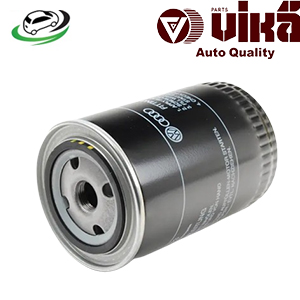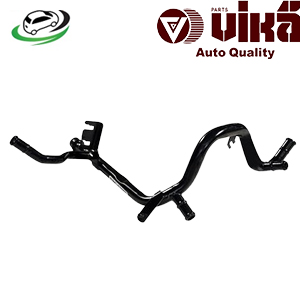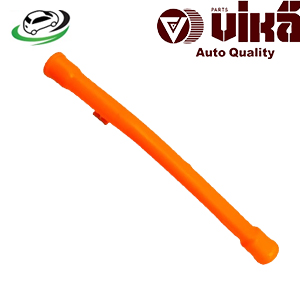-26%
Get AUDI TT MKI 180HP/225HP / VW 337/20AE/ Golf IV/ Jetta IV/ Jetta IV GLI/ New Beetle-1.8T Oil Dipstick Funnel 06A103663B
An oil dipstick funnel is a specialized tool designed to fit securely into the oil dipstick tube or oil filler neck of an engine, allowing oil to be added without spills. It acts as a conduit through which oil flows from the bottle or container into the engine. The funnel’s design typically includes a wide opening at the top to pour the oil and a narrow, precision tip at the bottom to fit snugly into the engine’s dipstick tube or oil filler port.
The oil dipstick funnel is essential for preventing spills and ensuring that oil is delivered directly into the engine without any leakage, making it an invaluable tool for both DIY vehicle enthusiasts and professional mechanics.
2. Function of an Oil Dipstick Funnel
The primary function of an oil dipstick funnel is to facilitate the addition of engine oil through the dipstick tube or oil filler neck in a clean and efficient manner. Here’s a more in-depth look at its specific functions:
1. Prevent Spillage and Waste
- Pouring oil directly from a bottle into the engine without a funnel can lead to messy spills, wasted oil, and contamination of surrounding components. The oil dipstick funnel provides a controlled path for the oil to flow into the engine, minimizing mess and waste.
2. Ensure Accurate Oil Top-Up
- The narrow tip of the funnel fits precisely into the oil dipstick tube or filler neck, ensuring that the oil is directed exactly where it needs to go. This reduces the risk of overfilling or underfilling the engine, which could lead to engine damage or poor performance.
3. Protect Engine Components
- Spilling oil in the engine bay can lead to contamination of other engine components, including belts, sensors, and electrical connections. An oil dipstick funnel helps keep the engine clean, preventing oil from dripping onto sensitive parts.
4. Ease of Use
- The funnel’s design makes it easy to pour oil into the engine without having to hold the oil bottle in an awkward position. This is especially useful for those with less experience or when working in tight spaces.
3. Design of an Oil Dipstick Funnel
The design of an oil dipstick funnel is simple yet effective. It consists of several key components that work together to make oil addition a breeze:
1. Wide-Mouth Opening
- The top of the funnel features a wide opening, making it easy to pour oil from large containers without the risk of spills. This wide mouth accommodates various types of oil bottles, from quart-sized to gallon-sized containers.
2. Narrow, Precision Tip
- The narrow tip at the bottom of the funnel is designed to fit snugly into the dipstick tube or oil filler neck. This ensures that oil flows smoothly into the engine without any leakage around the funnel.
3. Flexible or Rigid Body
- Oil dipstick funnels can come with either a flexible or rigid body. A flexible body allows for easy maneuverability in tight or awkward spaces, while a rigid funnel provides a sturdier structure for more precise pouring. Some funnels are designed with a detachable spout for added convenience.
4. Transparent or Opaque Material
- Many oil dipstick funnels are made from transparent plastic, allowing the user to see the oil as it flows through the funnel. This can help prevent overfilling and ensure that all the oil is delivered into the engine.
5. Built-in Filter (Optional)
- Some advanced oil dipstick funnels come equipped with a built-in filter or strainer. This feature helps catch any debris, dirt, or particles that may be present in the oil, preventing them from entering the engine and causing damage.
4. Types of Oil Dipstick Funnels
There are several different types of oil dipstick funnels available, each designed for specific applications and preferences:
1. Standard Oil Dipstick Funnel
- A simple, straightforward funnel designed to fit most vehicles. It usually has a wide opening and a narrow tip, making it suitable for general oil top-up purposes.
2. Flexible Oil Dipstick Funnel
- This type of funnel has a flexible spout, making it ideal for vehicles with hard-to-reach dipstick tubes or oil filler necks. The flexibility allows the funnel to bend and maneuver into tight spaces.
3. Long-Neck Oil Dipstick Funnel
- Long-neck funnels are designed for deep or recessed oil filler ports. The extended neck allows oil to be poured into difficult-to-access areas without spilling.
4. Funnel with Strainer
- A funnel with a built-in strainer adds an extra layer of protection by filtering out any impurities or debris that may be present in the oil. This is particularly useful when using oil that has been stored for a long time or when working in dirty environments.
5. Benefits of Using an Oil Dipstick Funnel
Using an oil dipstick funnel offers several key benefits, making it an essential tool for both routine maintenance and more complex engine repairs:
1. Clean Oil Addition
- The primary benefit of using a funnel is the ability to add oil without making a mess. It keeps the engine bay clean and prevents oil from dripping onto components that could be damaged by oil exposure.
2. Reduced Risk of Overfilling
- Pouring oil directly into the engine without a funnel can make it difficult to control the amount of oil being added. A funnel allows for more precise pouring, reducing the risk of overfilling the engine with oil.
3. Time-Saving
- The wide opening and narrow tip of the funnel make it easy to pour oil quickly and efficiently, saving time during routine maintenance or repairs.
4. Prevents Engine Contamination
- Spilled oil can attract dirt and debris, which may eventually enter the engine or contaminate other components. By using a funnel, you reduce the chances of contamination, keeping the engine cleaner and running more efficiently.
5. Improved Accessibility
- Flexible or long-neck funnels make it easier to reach oil filler ports in vehicles with complex or tight engine configurations. This makes oil top-up tasks more convenient, especially for DIY enthusiasts.
6. Common Problems and Troubleshooting
Though the oil dipstick funnel is a simple tool, it can present a few common issues if not used properly. Here’s how to troubleshoot some of the most common problems:
1. Oil Spillage
- Problem: Oil spills around the dipstick tube or filler neck.
- Solution: Ensure that the funnel is securely inserted into the dipstick tube or filler neck before pouring oil. If the funnel has a flexible spout, adjust its position to create a tighter seal.
2. Clogged Funnel
- Problem: Oil is not flowing through the funnel smoothly or becomes clogged.
- Solution: If the funnel has a built-in filter, check it for debris and clean it regularly. If the funnel is clogged with old oil residue, clean it with soap and water or an appropriate solvent before use.
3. Incorrect Funnel Size
- Problem: The funnel does not fit properly into the dipstick tube or oil filler neck.
- Solution: Ensure that the funnel is compatible with your vehicle’s engine. If necessary, purchase a funnel specifically designed for your vehicle or one with adjustable tips.
7. Maintenance and Care of an Oil Dipstick Funnel
To keep your oil dipstick funnel in good condition and ensure its longevity, follow these maintenance tips:
1. Clean After Each Use
- After adding oil, clean the funnel thoroughly to remove any residual oil and prevent dirt or debris from accumulating inside. Wipe it down with a rag and wash it with warm, soapy water if necessary.
2. Inspect for Damage
- Regularly inspect the funnel for cracks, splits, or other damage that could cause oil to leak during use. Replace the funnel if you notice any signs of wear.
3. Store Properly
- Store the funnel in a clean, dry place to prevent dust or debris from entering the funnel. Avoid storing it in direct sunlight or extreme temperatures, as this can cause plastic funnels to degrade over time.
4. Replace Worn or Damaged Funnels
- If your funnel shows signs of wear, damage, or cracking, replace it with a new one to ensure optimal performance during oil top-up tasks.
Conclusion
The oil dipstick funnel is an essential tool for anyone involved in vehicle maintenance, ensuring clean, efficient, and accurate oil top-ups. Its simple design, ease of use, and ability to prevent spillage make it an invaluable asset in keeping your engine running smoothly. Regular maintenance of your funnel, coupled with proper usage, can greatly improve the efficiency of your oil top-up process and help protect your vehicle’s engine from potential damage. Whether you’re a DIY enthusiast or a professional mechanic, having an oil dipstick funnel in your toolkit is a must for ensuring hassle-free oil maintenance.
Follow us on Facebook for more parts.




Reviews
Clear filtersThere are no reviews yet.